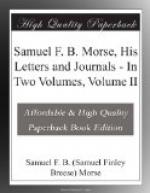The banquet was given at Delmonico’s, which was then on the corner of Fifth Avenue and Fourteenth Street, and was presided over by Chief Justice Salmon P. Chase, who had been the leading counsel against Morse in his first great lawsuit, but who now cheerfully acknowledged that to Morse and America the great invention of the telegraph was due. About two hundred men sat down at the tables, among them some of the most eminent in the country. Morse sat at the right of Chief Justice Chase, and Sir Edward Thornton, British Ambassador, on his left. When the time for speechmaking came, Cyrus Field read letters from President Andrew Johnson; from General Grant, President-elect; from Speaker Colfax, Admiral Farragut, and many others. He also read a telegram from Governor Alexander H. Bullock of Massachusetts: “Massachusetts honors her two sons—Franklin and Morse. The one conducted the lightning safely from the sky; the other conducts it beneath the ocean from continent to continent. The one tamed the lightning; the other makes it minister to human wants and human progress.”
From London came another message:—
“CYRUS W. FIELD, New York. The members of the joint committee of the Anglo-American and Atlantic Telegraph Companies hear with pleasure of the banquet to be given this evening to Professor Morse, and desire to greet that distinguished telegraphist, and wish him all the compliments of the season.”
Mr. Field added: “This telegram was sent from London at four o’clock this afternoon, and was delivered into the hands of your committee at 12.50.” This, naturally, elicited much applause and laughter.
Speeches then followed by other men prominent in various walks of life. Sir Edward Thornton said that he “had great satisfaction in being able to contribute his mite of that admiration and esteem for Professor Morse which must be felt by all for so great a benefactor of his fellow creatures and of posterity.”
Chief Justice Chase introduced the guest of the evening in the following graceful words:—
“Many shining names will at once occur to any one at all familiar with the history of the Telegraph. Among them I can pause to mention only those of Volta, the Italian, to whose discoveries the battery is due; Oersted, the Dane, who first discovered the magnetic properties of the electric current; Ampere and Arago, the Frenchmen, who prosecuted still further and most successfully similar researches; then Sturgeon, the Englishman, who may be said to have made the first electro-magnet; next, and not least illustrious among these illustrious men, our countryman Henry, who first showed the practicability of producing electro-magnetic effects by means of the galvanic current at distances infinitely great; and finally Steinheil, the German, who, after the invention of the Telegraph in all its material parts was complete, taught, in 1837, the use of the ground as part of the circuit. These are some of those searchers for truth whose names will be long held in grateful memory, and not among the least of their titles to gratitude and remembrance will be the discoveries which contributed to the possibility of the modern Telegraph.




